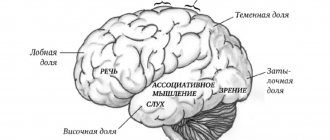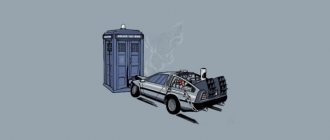Types of illusions
There are a lot of illusions.
Let's consider its most common types: Affective illusion, which is based on the emotional perception of an object. For example, a girl under the influence of fear in a dark alley will confuse a trash can with a standing person. You just have to approach the object to take a better look at it and dispel your illusion. However, fear and illusion will affect the behavior of the girl, who will run away from the trash can, thinking that he is a maniac. Illusion of attention (similar to the illusion of attitude) – can be increased or decreased
Increased attention means that a person can hear the phone ringing when he expects to hear it. Reduced attention consists of perceiving one word as another with a reluctance to study information
You may mistakenly read “Soulful Attitudes” instead of “Shower Attitudes.” Pareidolic illusions (pareidolia) - when a person sees a certain image in a certain drawing or even a set of chaotically constructed details. This image can be not only static, but also dynamic, for example, a person sees a herd of galloping horses in the picture, which is happening in motion.
Pareidolic illusions are the most interesting because they allow us to see by example how a person distorts the perception of the world. On one image, with the same lighting, location and color, he superimposes another image, which practically does not contradict the first.
Such well-known psychological advice as changing your attitude to what is happening is well based on this basis. When a person suffers from something, he is asked to change his attitude to what is happening, that is:
- To see reality as it is is to get rid of the illusion of the perception that causes a person to suffer.
- Come up with another illusion that is ideally superimposed on the first one under the same parameters and circumstances of what is happening.
There are other types of illusions:
- Verbal – when a person hears something other than what was said. For example, a person hears “How tired she is of you!” instead of “The rain has passed.” This illusion is very common. Everyone can remember how, instead of one word, he heard another, because of which the meaning of what was said was distorted.
- Cultural - a distorted perception of the world due to prejudices, religion, political position, etc.
- Personal - distorted perception due to experience, level of education, mental defenses, egocentrism, etc.
- Optical:
- Optical-physical - for example, a spoon that was immersed in water seems to be broken due to the reflection on the water.
- Physiological - for example, if you lift two objects of the same mass with both hands, and then replace one object with a third of the same mass, then in this hand the thing will be lighter than in the one where the object did not change.
- Metamorphopsia (organic illusion) – distorted visual perceptions in color, volume, shape, location. Stationary objects may begin to move when they actually remain in place.
- Auditory – when sound signals are distorted: tone, words, distance.
- Tactile – distortion of physical sensations.
- Gustatory, olfactory - when taste is perceived incorrectly, for example, sour seems sweet.
- Illusions of time perception - when a person gets lost in time, dates, calls a different time.
- Illusions of awareness - when a person thinks that someone is next to him. They are a harbinger of delusions or hallucinations.
Typical Perception Errors
Let's look at several mistakes that create obstacles to the correct perception and assessment of people. These may include:
- The effect of preliminary acquaintance, when attitudes, assessments, beliefs are set in advance, long before the start of the process of perception and assessment of other people (for example, someone said that a person is dishonest, you were not able to check this yourself, but you already have the expectation that he may deceive).
- The stereotype effect, which manifests itself in the presence of already formed stereotypes. In accordance with them, people are assigned to a certain category in advance, and a person in the process of communication has the intention of searching for traits that confirm the correctness of the stereotypical attitude.
- The effect of haste, which manifests itself in the form of a desire to make premature conclusions about the personality of the subject being assessed before receiving reliable, comprehensive information about him.
- The structuring effect, when unconscious structuring of the personality of other people occurs. Here, only strictly defined personality traits are logically combined into a holistic image, while any concept that does not fit into this image is discarded.
- The “halo” effect occurs when the initial attitude towards a single personality characteristic can be transferred to a holistic image of a person. Subsequently, the general incomplete impression has an impact on the assessment of individual qualities of the face.
Do you need proofreading or review of academic work? Ask a question to the teacher and get an answer in 15 minutes! Ask a Question
Types of illusions
Following Karl Jaspers, we will consider these types of illusions.
The first is affective, associated with an emotional state, most often fear. For example, a girl walks along a dark alley at night, hurrying and being careful of everything, and sees a maniac in a dark corner. However, this is just a trash can. To dispel the illusory perception, it is necessary to improve the conditions of contact with this object, for example, by coming closer and having a better look at it, the girl would understand that there is no maniac. However, she will not do this and the illusory perception will influence her behavior.
The second type is illusions of attention. They can be compared with installation illusions; they have similar mechanisms
Attention can be increased or decreased. Increased attention also often appears in conjunction with an emotional state
They often arise when waiting for something important - a call, a message, a person’s arrival. Situations of reduced attention are, for example, when a tired student prepares for an exam at night and reads one word instead of another
The connection between illusion and attitude can be illustrated with a comic example. A psychologist walks down the street and sees the book “Mental Attitudes” in the window of a store. He comes in with the desire to look through and perhaps buy, but sees that the book is called “Shower Installations.”
And the third type is pareidolic illusions, also called pareidolia. The name comes from the Greek words para - next to and eidolon - image. An example of such an illusion is a situation when a person looks at a carpet, and instead of a pattern he sees something that is not depicted: animals, faces. From the elements of the drawing, he builds something else, restructures the drawing. Such illusions are observed by people with a highly developed imagination, in borderline states or with illnesses.
Pareidolic illusions can be static or moving - for example, in a pattern you can see a herd of galloping deer. Unlike other illusory perceptions, pareidolia is difficult to dispel. Looking more and more closely, a person perceives the illusion only more real. However, it is possible to reach a certain point of illusoryness that allows you to switch these images of perception.
Pareidolic illusions most convincingly illustrate that distortions of perception are based on a restructuring of the system of intra-subject relations, which is well explained by Gestalt psychologists. When a different form is applied to the elements of the drawing, the connections between the elements are rethought, a new image is obtained, it is built into the system of intersubject relations. For example, a trash can in the dark side of the alley, which was instead of a maniac in the girl’s imagination, when examined, is located in the same place where the maniac was seen and is also illuminated.
Illusions can also be classified by modality. Verbal illusions can be distinguished separately. A good example of verbal perception can be seen in Nabokov's Lolita. Humbert brings Lolita to the hotel, it’s night, it’s raining, a lantern breaks - a tense atmosphere, Humbert, in thought, hears the voice of a stranger: “How did you get her?” He asks again: “Excuse me?” “The rain has stopped,” says the stranger. And further in the conversation Humbert says: “She is my daughter.” “You’re lying, not your daughter,” he hears the answer again, and he asks again. “The rain has stopped,” says the stranger. This is a perfect illustration of the fact that we hear what we want or are afraid to hear.
We are on Telegram! Subscribe and be the first to know about new publications!
Perception disorders (illusions, psychosensory disorders)
The process of perception reflects the integral objects of reality in the unity of their inherent qualities. They arise from the direct action of a stimulus on the sense organs. Perception disorders include illusions and disorders of psychosensory synthesis.
Illusions
Illusions are understood not simply as incorrect perception, but as qualitatively incorrect, distorted, associated with erroneous recognition of objects and phenomena, when completely different objects and phenomena are perceived instead of some objects of reality. For example, a table lamp is perceived as the head of some kind of animal, a coat hanging on a hanger is perceived as the figure of a lurking person. Illusory perception is often indistinguishable in sensory terms from normal perceptions in terms of brightness, color, clarity, realism, persuasiveness and other characteristics. Therefore, criticism of illusory deceptions of perception is usually absent. The patient is confident that he really “sees” or “hears” something, even if it contradicts common sense due to its fantasticality, implausibility, and unusualness.
In psychology textbooks, illusions often include optical, physiological and some other illusions: a stick half-lowered in water appears to be broken (optical illusion), landscapes visible in the window of a moving train appear to be in continuous motion (physiological illusion). In psychiatry, the understanding of illusions is usually narrower and more specific, often related to pathology. It is not associated with outwardly similar phenomena caused by the laws of optics, physiology, including mirages, etc. Only qualitatively incorrect perception is illusory from the standpoint of psychiatry. This understanding of illusions is justified by clinical practice and diagnostic meaning. A number of psychologists explain illusions as the result of a fusion of distorted perception and qualitatively different representation.
There are visual, auditory, and affective illusions. Olfactory and tactile illusions rarely distinguish tastes. Particularly relevant are affective illusions, which are largely associated with stress, the experience of intense anxiety, fear, and depression. So, if you force a person to spend the night alone in a cemetery, then many will hear unclear voices of threatening and condemning in the rustling of leaves. content (auditory illusions), and the outline of the tombstones can be perceived as the figure of a lurking person (visual illusions!
There are pareidolic illusions. These include complex, scene-like, and sometimes fantastic visual illusions. In the design of the carpet, wallpaper, frosty patterns on glass, and passing clouds, the patient sees fabulous animals, people, and other living creatures. Sometimes illusory visions kaleidoscopically replace each other sequentially, in meaning, reminiscent of a film.
In some cases, patients are convinced of the reality of illusory experiences. There is no criticism. In other cases, especially when the illusions are short-lived, vague, and unclear, criticism would be restored. Illusory perception - psychotic or. at least a subpsychotic symptom. Abundant visual illusions are a common sign of altered consciousness. Illusions occur in a variety of forms of mental and somatic pathology. In addition to stress, anxiety, fear, insufficient lighting, excessive noise in rooms, defects in vision and hearing, other sense organs, excessive impressionability, daydreaming, a tendency to fantasize, increased suggestibility, overwork, and sleep disorders contribute to illusory perception.
Psychosensory disorders
Metamorphopsia
Metamorphopsia includes incorrect perception of shape, size, ratio, relative position, structure and other similar disturbances of objects and phenomena. Unlike illusions, the essence of the purpose and function of objects is recognized correctly. Objects are perceived as sharply increased in size, pieces of furniture are huge, filling the entire room (macropsia), household items seem greatly reduced (micropsia), doubled or tripled, curved (dysmegalopsia). The space seems enlarged, the street seems endless. Sometimes the walls of the house appear tilted, it seems that they are about to collapse and crush a person. Possible weightlessness of objects, other violations of ideas about the surrounding reality. Under visual control, metamorphopsia disappears. They usually recur when control is lost.
Body schema disorders
Violations of the body diagram are expressed in an erroneous perception of the size, shape, relationship and location of body parts. Its own head seems huge, there is no neck, the arm is placed on the back, the head is separated from the body. Looking at and feeling yourself helps to temporarily correct, in whole or in part, the image of your own body.
Violations of optical-spatial representations
A person who gets out of a subway car every day, doing it automatically, suddenly loses the ability to navigate, makes a mistake and goes in the opposite direction.
How are illusions different from hallucinations?
Life situations can create conditions under which people experience perceptual disturbances. Illusions and hallucinations can cause such disorders; even a healthy person is not protected from them. How to distinguish one from the other:
- As a result of illusion, one can see real things from a completely different side or with a greater distortion of reality. Common mistakes with which a person can see something, for example, in the dark, mistaking some things and objects for others, or mistaking a bright leaf from a tree for a mushroom cap, can occur in completely healthy people. Such errors should be distinguished from a painful perception of reality.
- Hallucinations appear where there is nothing. Haunting images can occur against the background of psychosis. In healthy people they occur if they are in a state where their consciousness is altered.
Illusions of perception. Brief classification
Illusions are disorders of perception in which real phenomena or objects are perceived by a person in a changed, erroneous form. Illusory perception can also occur against the background of complete mental health, when distorted perception is associated with a deficiency of one or another sensory organ or with the manifestation of one of the laws of physics.
A classic example: a spoon in a glass of tea seems to be refracted, as R. Descartes said: “My eye refracts it, but my mind straightens it.”
There are also illusions of inattention (K. Jaspers), when a healthy person, when diverting attention to something very important, can perceive the surroundings erroneously.
Illusions associated with mental disorders are most often divided into affective or affectogenic, verbal and pareidolic.
Affective (affectogenic) illusions arise under the influence of a strong feeling, such affect as strong fear, excessive nervous tension. In such a tense state, a person mistakenly perceives a transparent curtain as a swinging skeleton, a coat on a hanger seems like a scary tramp, a tie on the back of a chair looks like a crawling snake, threats against oneself can be heard in the noise of the fan, etc.
Verbal illusions (from the Latin verbalis - oral, verbal) are expressed in an erroneous perception of the meaning of words, speeches of others, when instead of a conversation that is neutral for the patient, he hears (which usually also happens against a background of strong fear) threats, curses, accusations allegedly related to him.
Pareidolic illusions (from the Greek para - near, near + eidoles - image) are perception disorders when truly existing images are perceived as changing, usually in a bizarre and fantastic form. For example, a pattern on wallpaper is perceived as a giant toad, a shadow from a floor lamp - like the head of some terrible lizard, patterns on a carpet - like a beautiful, never-before-seen landscape, the outlines of clouds - like a picturesque group of people.
Illusions are divided according to the senses, but most often they are visual and auditory . They can also occur briefly in healthy people who are in a state of anxiety, tense anticipation, or strong excitement. However, most likely they signal the beginning of psychosis, an illness, often of an intoxicating or infectious nature.
A vivid and very poetic illustration of illusory perception can be found in Goethe’s ballad “The Forest King” (translation by V. A. Zhukovsky). Here are two excerpts.
“Child, why are you clinging to me so timidly?” “Darling, the king of the forest sparkled in my eyes. He wears a dark crown and a thick beard. - Oh, no, the fog over the water is white.
- Dear, the king of the forest speaks to me: He promises gold, pearls and joy. - Oh, no, my baby, you misheard; Then the wind, waking up, swayed the sheets.
What types of illusions are there?
For every sense organ there is at least one illusion, there are a lot of them. The types of illusions that a person can experience have their own division:
- optical – this is an erroneous visual perception;
- sound – hearing loss;
- physiological - peripheral or central parts of the sense organs did not work correctly;
- awareness - a feeling of presence, also classified as a form of hallucination;
- physical – associated with natural phenomena;
- affective - can appear with a sharp change in mood;
- organic – erroneous perception of colors, sizes and shapes;
- pareidological - creating pictures using thoughts.
Pareidolic illusions
Illusory perceptions of real objects are called pareidological illusions. Such illusions can arise when a person examines a pattern of wallpaper, fabric, stains or cracks, or clouds. You can see not only faces or objects, but also fantastic images. This happens as a result of the effect of a dual image, when the illusion of depth or recognition images is created specifically for provocation. This appearance can be observed in several people at once when examining some well-known object, for example, a cultural property.
Affective illusions
Being in a certain emotional state of mind, and at the same time, finding himself in an unfamiliar place, a person is able to see almost incredible things. A striking example is a night visit to a cemetery. Being under the influence of fear and expecting something bad, any person is able to see an affective illusion. Or if there is a fear of spiders, and there is a new, unfamiliar place, a person will be afraid of their appearance from everywhere. Many people are able to see different types of illusions. Affective illusion can appear even in a healthy person.
Physical illusions
Some pilots in their stories emphasize that if you fly over the sea when the stars are reflected in it, you get the feeling of an inverted flight. The main feature of physical illusions is their dependence on the mental state
Physiological or physical illusions are short-term phenomena, they are episodic. If a person is able to critically assess the situation and understand that it is an illusion, then this indicates his psychological health.
How are physiological illusions created? A striking example is a violation of the eye, when “by eye” it is very difficult to determine the distance from a person to an object. Real indicators and a false perception of distance give rise to this type of illusion. Almost all people encounter this type of illusion and, knowing that it is an illusion, easily correct it. This type of illusion is a feature of the structure of the eye and lighting effects.
The essence and characteristics of perception errors
The most important characteristics in the process of communication are those that make it possible to assign a person to a particular group. The perception of these characteristics occurs quite accurately. Next, the remaining features and features are completed in accordance with certain schemes. It is at this stage that the possibility of error arises.
Need advice on your academic work? Ask a question to the teacher and get an answer in 15 minutes! Ask a Question
Note 1
Perceptual errors are, in part, driven by individual factors including superiority, attractiveness, and attitude.
People who enter into communication are not equal to each other. They are distinguished by social status, life experience, intellectual potential, etc. In the case of inequality between partners, a perception scheme is most often used, which contributes to the occurrence of errors of inequality. Psychology classifies this type of error as a factor of superiority.
When meeting a person who is superior to another in some important parameter, the assessment is made somewhat more positively than it would be if he were on an equal footing. If a person is dealing with a person whom he is superior in some way, then an underestimation occurs.
Superiority is recorded based on a single parameter, and overestimation (underestimation) is made based on several parameters. This perception scheme does not apply to any, but only to truly important, significant inequality.
There are also perception errors that can make mutual understanding difficult. In addition to stereotypes, the process of perceiving and understanding other people is influenced by other factors that contribute to the distortion of the image of other people and complicate mutual understanding. Attitudes can cause a distorted idea of the personality of other subjects.
Definition 3
An attitude in psychology is an unconscious readiness for some behavior that has formed in a person. This is the willingness to react positively or negatively to certain events or facts.
The attitude manifests itself in the form of habitual judgments, ideas, and actions. If once it has been depleted, it will remain for a more or less long period of time. The speed of formation and attenuation of installations, as well as their mobility, will be different.
Attitudes as an unconscious readiness to perceive others and events from a certain angle and react in a certain, initially formed way, without an objective analysis of the situation, are created on the basis of the individual’s personal previous experience or under the influence of other persons.
Example 1
In a famous experiment by A. Bodalev, two groups were offered a photograph of the same person. The subjects had to create a psychological portrait of him. Before this, one group was given the instruction that the photo showed a criminal, and the other group was told that the photo showed a hero. The study showed that the formation of perception occurred depending on the initial attitudes.
Attitudes can be positive or negative, depending on whether a person is prepared to relate negatively or positively to a particular person or situation. Such negative preconceptions can interfere with an objective understanding of the actions of real people. Examples could be the following attitudes: “all officials take bribes”, “all people are selfish”, “all men are polygamous”, etc.
What is an illusion?
A similar phenomenon can be created by a skilled magician or mother nature herself, but it happens that a person deceives himself. An illusion is when a real object or phenomenon is perceived in a distorted form and is understood ambiguously. It is believed that illusion is a companion to any mental illness, but this is not entirely true; a healthy person is also capable of experiencing illusion. How can you see an illusion?
- Due to optical illusion.
- Being in a state that is unusual for a person (drug intoxication, pathology or emotional state).
In everyday terms, illusion refers to hopes and dreams. The unreal world that illusion creates is a world of self-deception, and serves as a means that makes life easier for a person or is even a flight of his imagination. Human consciousness always strives to protect itself from shocks and strive for illusion, encourages dreams of a miracle, creates images of a “beautiful life” or ideal people.
Types of quantitative perception disorder
Quantitative disturbances of perception are characterized by changes in the strength of perception of natural stimuli. These include:
- Types of qualitative disturbances of perception
- A qualitative disturbance of sensations associated primarily with neurological lesions is called paresthesia.
- The main types of qualitative disturbances of perception are illusions, hallucinations and senestopathies.
- Illusion is a false perception of real things, objects or phenomena with a distortion of their true meaning.
Illusory perception consists in the fact that the ideas prevailing in consciousness are transformed in a certain way or “complete” the objects of the surrounding reality. This can occur under the influence of strong emotions (affective illusions - also occur in mentally healthy people when experiencing anxiety, fear, joyful anticipation, etc.).
People with a delusional mood may have interpretive illusions (the imagination transforms or draws real objects and events in such a way that they confirm the content of the delusion: a person who believes that the whole world has turned against him “hears” threats and threats in the words of a weather forecast commentator on TV dirty curses addressed to oneself). Against the background of a reduced level of consciousness, visual illusions arise, which are called pareidolia, in which shapeless or insufficiently clear objects (spots, cracks on the wall, shadows, carpet or wallpaper patterns) are “completed” by the imagination into bizarre images of people, animals, monsters. The peculiarity of pareidolic illusions is that they easily lose touch with the real object and turn into visual hallucinations.
There are also illusions with a false perception of the size and shape of objects while maintaining their true meaning (illusions of size and shape - metamorphopsia, which can also relate to the perception of one's own body - a violation of the body diagram). These types of illusions are characteristic of derealization and depersonalization (psychosensory disorders).
Illusions of perception from a psychological point of view
Illusions of perception by psychology are considered as observations of phenomena
And it doesn’t matter if a person understands the practical impossibility of what is happening. Thus, we are able to see mirages, distortions of objects in transparent liquids, etc.
In this way, new object images are formed instead of real, real objects. The term illusion is sometimes used to define irritating configurations that cause distorted perception. Psychologists do not consider illusions to be a deviation from the norm. While psychiatrists and psychoanalysts deal with hallucinations and delusions.
Why is illusory perception needed, what functionality do psychologists give it?
People have illusions to remove some uncertainty and resolve certain controversial situations. This process resembles the animation of experiences. Each of us is always trying to find an explanation for our worries. Through illusions they get the opportunity to streamline and organize the vision of an object. Thus, illusions are given a compensatory role. They actually help resolve uncertainty, relax and eliminate anxiety that arises in ambiguous situations. The coloring of the illusory image, figure and background does not matter. In any case, this serves as a kind of warning, a signal to action. But often such a basis leads to erroneous decisions.
What are optical illusions?
There are many types of illusions. Scientists classified them according to different criteria: perception of the size of objects, colors, size of figures depending on the background, apparent objects, movement, depth. This also includes conditions created by nature. Let's briefly look at the most famous and interesting of all.
There are optical illusions created by nature. A well-known example is a mirage in the desert. A person, in turn, can also create imaginary phenomena and objects using visual effects, for example, floating in the air (levitation). People have learned to understand natural optical illusions, also creating illusory visual pictures. The illusion of color perception is one of the most famous types, which arises due to the special structure of the retina.
The effect of false perception of size is due to the fact that vision quite often incorrectly estimates geometric quantities. One study found that our eye can be off by up to 25% in its measurements, since its estimates are highly dependent on the nature of the background of these images. There have been cases when one phenomenon had several variants of scientific explanations. This suggests that there is still a lot of unexplored and mysterious things in this area, despite many years of research.
MagazinLinz.ru team
Types of illusions of perception (deception of the senses)
May occur in mentally healthy people (physical, physiological illusions):
- Physical - associated with the objective laws of physics operating in the world (for example, an optical illusion: a teaspoon immersed in a glass of water is perceived as broken). Optical - errors in visual perception caused by inaccuracy or inadequacy of the processes of unconscious correction of the visual image (for example, if you examine an object through a pseudoscope, then, due to the negative disparity created by the device, a person gets the opportunity to observe the effects of reverse perspective)
- Sounds, such as Shepard's tone.
- Auditory - distorted perception of sound characteristics: strength, rhythm, distance to the sound source.
| Pictures that cause optical illusions |
|
Illusions in psychiatry
Main article: Illusion (psychiatry)
- Illusions in psychiatry - arising as a consequence of a mental disorder. This form of illusion is not associated with the externally similar phenomena described above, which are determined by the laws of physiology and optics. Auditory, visual, olfactory, gustatory, tactile, vestibular.
- Pareidolia (pareidolic illusions) is a special type of illusion in which complex fantastic pictures emerge and gradually develop from complex patterns (on a carpet, winter glass).
- Affective (mental illusions, emotional illusions) - arise under the influence of pronounced mood swings or in connection with an acutely developing affect of fear and anxiety.
- Illusions of awareness (embodied awareness) - the feeling that someone is supposedly nearby; this type of illusion was identified by K. Jaspers [ source not specified 472 days
];
According to the author, this type of illusion is a sign of the formation of hallucinations and delusions [ source not specified 472 days
].
According to other classifications, such a sensation is a hallucination of a general feeling
.
Illusions – distorted perception of objects and phenomena (objects)
Illusions, unlike hallucinations, can also occur in a completely healthy person.
Physical illusions
The reason for their occurrence is, for example, the laws of physics (the well-known broken spoon in a glass of water, which arises due to different light transmittance of the media).
Physiologically illusions
Occur under special conditions of the analyzer (for example, when driving in transport, there is a feeling that the car continues to move even when the driver presses the brake or a frozen picture of nature outside the window of a moving train);
Psychic illusions
They arise when a person perceives objects or objects inadequately due to his special mental state (affect). When a feeling of fear, anxiety is expressed, and, being in tension, we expect something dangerous for us, an ordinary branch outside the window in the dark may seem like a monster to us, and affectogenic illusions . When, against the background of strong emotions, threats, accusations, and misunderstandings of the meaning of the words of others are heard in ordinary conversation, verbal illusions can arise. With mild non-productive disturbances of consciousness as a result of intoxication, elevated temperature, surrounding objects can take on a fantastic appearance (pareidolic illusions ).
Sometimes illusions can arise in conditions of difficult perception, for example, twilight disorders of consciousness.
What is illusion
In psychology, this is the formation of a new supramodal object image to replace the image of a real, real object. Simply put, this is when a person perceives one thing instead of another.
The concept of illusion is also sometimes used to refer to the very configurations of stimuli from which inadequate perception is built.
In psychology, illusion is a phenomenon characteristic of healthy people. Whereas hallucinations and delusions are already being studied by psychiatrists and psychoanalysts.
What is the purpose of illusory perception, what is the function assigned to it in the mental reality of man? Illusions arise to remove some uncertainty, to resolve some controversial situation. Similar to the process of objectification of anxiety, when a person worries about something and looks for an explanation, a reason, a way out for his anxiety and finds this object, then through the formed objective image, through an illusion, a person receives an ordered organization of the perceived material. Thus, illusions play a compensatory role, helping to resolve uncertainty, tension and anxiety that arise from the ambiguity of what is happening. Even if the object image that appears is negatively colored, the psyche strives to create it, since then it is at least clear to the person what needs to be feared, and one can proceed to action. Of course, actions based on illusory perception will be erroneous.
The emergence of illusory perception is also socially determined. More than one experiment was conducted when the initially correct perception of the subject was directly influenced by the behavior of the rest of the mass of people and the vast majority of the subjects lost the acuity of perception under the pressure of society. The distortion of perception is influenced by our motivation, since, depending on desires and unconscious aspirations, a person can form false images. Past experience also matters, when a person is already accustomed to perceiving a particular phenomenon in a certain way.
When the stimulus changes, the image of the object may remain the same or become distorted, which is especially noticeable with professional deformation. Thanks to habits, a person not only reduces time and resources for performing a familiar task, but also loses the ability to perceive it vividly, freshly and completely correctly even with minor deviations from the usual course of events. Depending on the needs, while trying to satisfy them, you can also get the wrong image of the object. An example here is a mirage in the desert, which is seen by tired and thirsty travelers. Of course, the level of intellectual development also influences the number of errors in the perception of reality, because it is known that ignorance of certain phenomena gives rise to rumors and legends.
The emotional state also plays a significant role in the creation of illusory perception; in sadness and joy, you can see different details and meanings in one picture. The transformation of images of reality involves attitudes, a picture of the world, and semantic formations. It is interesting that the characteristics of a person’s illusions can speak about his typological characteristics as a person, character traits, psychological state, self-esteem, susceptibility to suggestion, and pathological disorders. Also, the occurrence of illusory perception can be influenced by the actualization in the mind of the image of a significant other person or the situation of interaction with her.
Peculiarities of perception
Perception can be determined by the idea of the partner formed during communication. Psychological research shows that the basis for the perception of previously unfamiliar faces and persons with whom we already have some experience of communication are various psychological mechanisms. In one case, perception occurs through the psychological mechanisms of intergroup communication, in the other - through the mechanisms of interpersonal communication.
Finished works on a similar topic
Course work Errors of perception in psychology 400 ₽ Essay Errors of perception in psychology 240 ₽ Test paper Errors of perception in psychology 220 ₽
Receive completed work or specialist advice on your educational project Find out the cost
Psychological mechanisms of perception within the framework of intergroup communication include social stereotyping, the essence of which is to build an image of another person based on certain standard patterns.
Definition 2
A social stereotype is a stable idea about certain phenomena or persons. It is typical for representatives of the corresponding social group.
Different social groups, when interacting with each other, develop social stereotypes, which can be, for example, ethnic (national).








